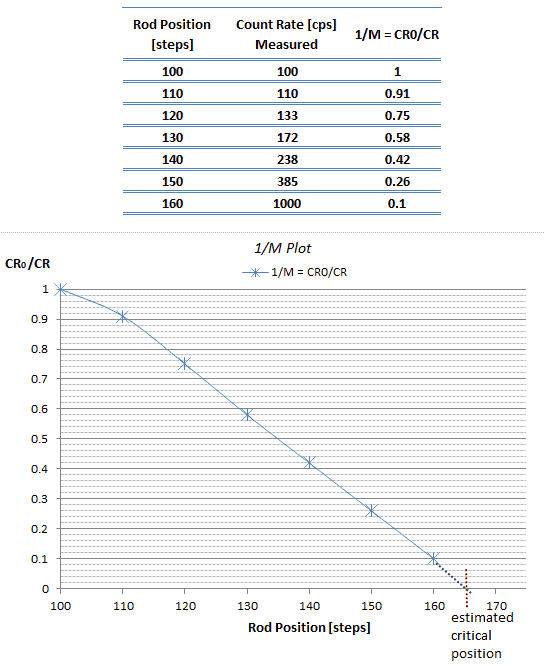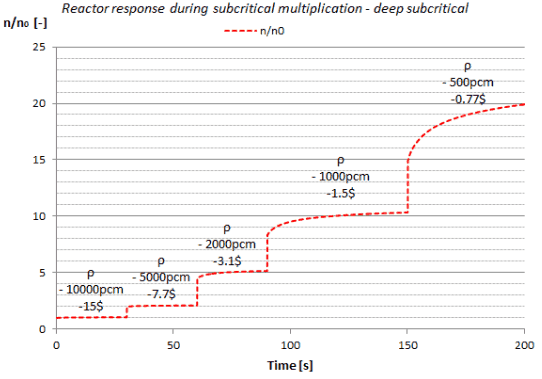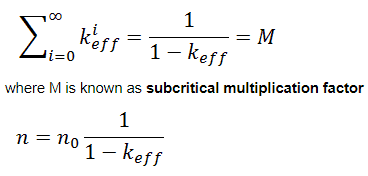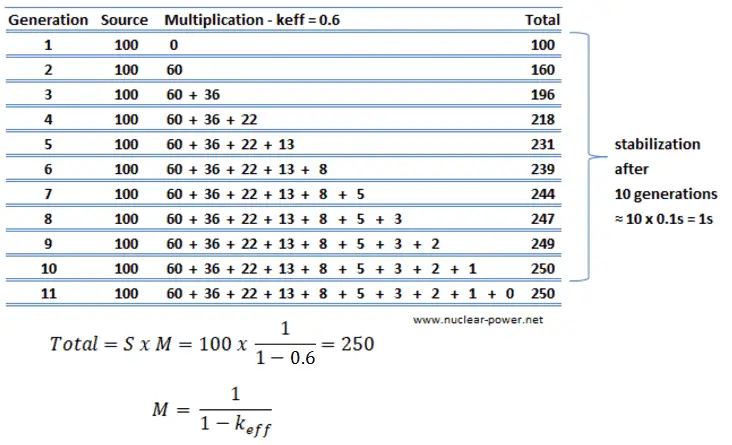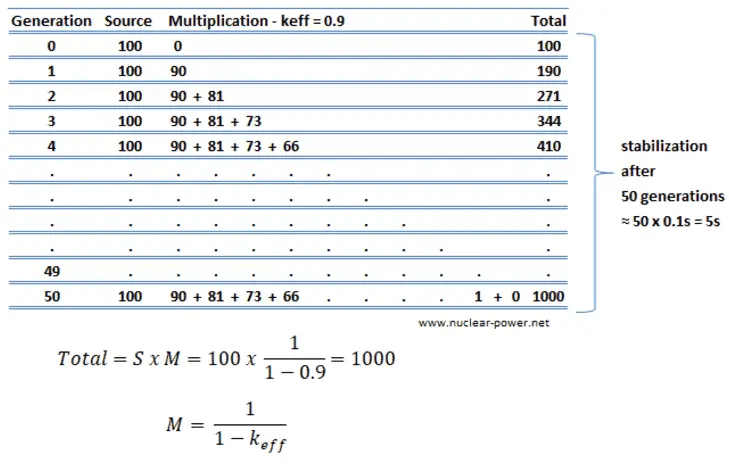During a PWR startup, the value of keff increases and:
- the steady-state neutron level increases (by factor M)
- time of stabilization increases (let say 1/100 = keffi → tstab = ln(0.01) / ln (keff) x ld)
In previous chapters, especially in the Reactor Criticality chapter, the basic classification of states of a reactor according to the multiplication factor was defined. One of these states is a subcritical state defined as:
- keff < 1. If the multiplication factor for a multiplying system is less than 1.0, then the number of neutrons is decreasing in time (with the mean generation time) and the chain reaction will never be self-sustaining. This condition is known as the subcritical state.
But this statement is not completely correct. To clarify this issue, we use a finer classification of subcritical states. The subcritical state can be subdivided into:
- transitional subcritical state. Typical feature of this state is a decrease in neutron flux. The above definition is, in fact, a definition of the transitional subcritical state, in which the reactivity of a reactor is lower than zero (keff < 1; ρ < 0). In this case, the production of all neutrons by fission is insufficient to balance neutron losses and the chain reaction is not self-sustaining.
- steady-state subcritical state – subcritical multiplication. Typical feature of subcritical multiplication is a presence of source neutrons (supplied by external or internal neutron source). The source neutrons balances neutron losses and the neutron flux is constant. If an external neutron source is present, then any transitional subcritical state inevitably pass in subcritical multiplication. If not, the neutron flux will approach zero.

Theory of Subcritical Multiplication
Definition:
In general, subcritical multiplication is the phenomenon that accounts for the changes in neutron flux that takes place in a subcritical reactor with source neutrons due to reactivity changes.
An equation governing the kinetics of a subcritical reactor can be written as:
where:
- n(t) is transient reactor power
- n(0) is initial reactor power
- keff is the effective multiplication factor
- ld is the mean generation time with delayed neutrons
- S(t) is the source term, which characterizes number of neutrons (source neutrons) added to the system from an external source. As can be seen, the source term does not influence the dynamics of the system, since it does not influence the reactivity of the system.
Kinetics of Subcritical Multiplication
Source neutrons play an important role in reactor safety, especially during shutdown state and reactor startup. Without source neutrons, there would be no subcritical multiplication and the neutron population in the subcritical system would gradually approach to zero. That means, each neutron generation would have fewer neutrons than the previous one because keff is less than 1.0.
With source neutrons, the population remains at levels that can be measured by the source range excore neutron detectors, so that operators can always monitor how fast the neutron population is changing (can always monitor the reactivity of subcritical reactor). Note that, if neutrons and fissionable material are present in the subcritical reactor, fission will take place (even a deep subcritical reactor will always be producing a small number of fissions).
The source neutrons enter the life cycle and experience the same environment that fission neutrons experience. It must be noted, source neutrons are produced at different energies (e.g., 24keV for Sb-Be source), usually below energies of fission neutrons.
When the reactor is made subcritical after operating at a critical state, the neutron population at first undergoes a prompt drop as a result of rapid decrease in prompt neutrons. After a short time begins to decrease exponentially with a period corresponding to decay of the longest-lived delayed neutron precursors (i.e., ~80s). With source neutrons, the neutron flux stabilizes itself at a corresponding level, which is determined by source strength, S, and by the multiplication factor, keff.
For a defined source strength of n0 neutrons per neutron generation, the neutron population (i.e., the neutron flux) is given by:
where, n0 are source neutrons (0. generation) and n0keffi are neutrons from i-th generation. As i goes to infinity, the sum of this geometric series is (for keff < 1):
As can be seen, the neutron population of a subcritical reactor with source neutrons does not drop to zero, the neutron population stabilizes itself at level n, which is equal to source multiplied by factor M.
Example: Subcritical Multiplication
keff = 0.6
Consider a reactor in which:
- keff = 0.6
- the mean neutron generation to be ld = 0.1s
- the external source provides n0 = 100 neutrons/s.
That means, when 100 neutrons are suddenly introduced into the reactor via source n0. These neutrons will produce 60 neutrons (100 x 0.6) from fission to start the next generation. Duration of each neutron generation is equal to ld = 0.1s. From 60 neutrons of the second generation the system will produce 36 neutrons (60 x 0.6) to start the third generation (during ld = 0.1s). The number of neutrons produced by fission in subsequent generations due to the introduction of 100 source neutrons into the reactor is shown in the figure.
As can be seen, the neutron population stabilizes itself at level n = 250, which is equal to source multiplied by factor M. The addition of source neutrons to the reactor containing fissionable material has the effect of maintaining a much higher stable neutron level due to the fissions occurring than the neutron level that would result from the source neutrons alone. As can be seen, the amount of time it takes to reach the steady-state neutron level is approximately equal to time of 10 neutron generations (i.e., 10 x 0.1s = 1s).
Now, we will illustrate, what happens to the neutron population when the value of keff is changed. During a reactor startup, for example, an initially subcritical reactor is driven to criticality via a series of discrete control rod withdrawals. During these withdrawals a reactivity increases. After each control rod withdrawal, the operator must wait to allow the reactor to attain the steady-state neutron level. The amount of time it takes to reach the steady-state neutron level after a reactivity change increases as keff approaches the critical state.
keff = 0.9
Consider a reactor in which:
- keff = 0.9
- the mean neutron generation to be ld = 0.1s
- The external source provides n0 = 100 neutrons/s.
That means, when 100 neutrons are suddenly introduced into the reactor via source n0. These neutrons will produce 90 neutrons (100 x 0.9) from fission to start the next generation. Duration of each neutron generation is equal to ld = 0.1s. From 90 neutrons of the second generation the system will produce 81 neutrons (90 x 0.9) to start the third generation (during ld = 0.1s). The number of neutrons produced by fission in subsequent generations due to the introduction of 100 source neutrons into the reactor is shown in the figure.
As can be seen, the neutron population stabilizes itself at level n = 1000, which is equal to source multiplied by factor M. As can be seen, the amount of time it takes to reach the steady-state neutron level is significantly higher, since it is approximately equal to time of 50 neutron generations (i.e., 50 x 0.1s = 5s). The reason is evident in the series expression in the figure for keff = 0.9. As keff increases, more terms in the series are significant, meaning that more previous generations of source neutrons contribute to the present population.
Summary
Therefore, during a reactor startup, the value of keff increases and:
- the steady-state neutron level increases (by factor M)
- time of stabilization increases (let say 1/100 = keffi → tstab = ln(0.01) / ln (keff) x ld)
It must be noted, the real PWR cores reach reactivities around keff = 0.92 – 0.95 at the beginning of the reactor startup. Values around 0.6 are not common.
1/M Plot
It is obvious the subcritical multiplication factor significantly rises:
Because the subcritical multiplication factor is related to the value of keff (core subcriticality), it is possible to monitor the approach to criticality through the use of the subcritical multiplication factor. The closer the reactor is to criticality, the faster M will increase for equal step insertions of positive reactivity. When the reactor becomes critical, M will be infinitely large. Monitoring and plotting M during a criticality approach is impractical because there is no value of M at which the reactor clearly becomes critical.
On the other hand, the neutron flux is monitored via source-range detectors, where count rate (CR) gets infinitely large as the core approaches keff = 1.0. Note that, the count rate of source-range detectors is proportional to the neutron population (n ∝ CR). which can be determined by source-range count rate.
Therefore, instead of plotting M directly, its inverse (1/M or 1/CR) is plotted on a graph of:
- 1/CR versus rod elevation (in case of criticality approach by control rod withdrawal)
- 1/CR versus boron concentration (in case of criticality approach by boron dilution)
- 1/CR versus number of fuel assemblies (in case of loading of fuel into the core)
Note that, a true 1/M plot requires knowledge of the neutron source strength. Because the actual source strength is usually unknown, a reference count rate is substituted. As criticality is approached, 1/CR approaches zero. Therefore in startup procedure the value of 1/CR provides engineers with an effective tool for monitoring the approach to criticality.
Example of 1/M Plot
Assume a criticality approach by control rod withdrawal. For this procedure operators check especially the control rods position (usually in steps) and the count rate (CR) from source-range detectors. The initial count rate on the detectors prior to rod withdrawal is 100 cps. There are main parameters in the following table. From these parameters the 1/M Plot is constructed. As can be seen, the estimated critical parameters can be predicted with extrapolation to the point, where CR0/CR → 0.
